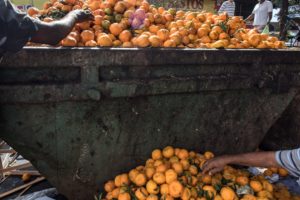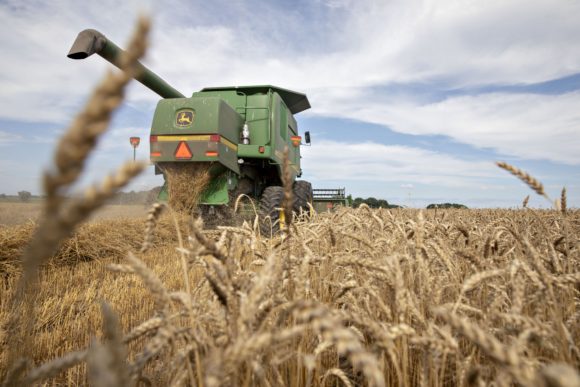Wild weather is wreaking havoc on crops around the world, sending their prices skyrocketing.
On wheat farms in the U.S. and Russia, it’s a drought that’s ruining harvests. The soybean fields of Brazil are bone dry too, touched by little more than the occasional shower. In Vietnam, Malaysia and Indonesia, the problem is the exact opposite. Torrential downpours are causing flooding in rice fields and stands of oil palm trees.
The sudden emergence of these supply strains is a big blow to a global economy that has been struggling to regain its footing after the shock of the Covid-19 lockdowns. As prices soar on everything from sugar to cooking oil, millions of working-class families that had already been forced to scale back food purchases in the pandemic are being thrust deeper into financial distress.
What’s more, these increases threaten to push up broader inflation indexes in some countries and could make it harder for central bankers to keep providing monetary stimulus to shore up growth.
The Bloomberg Agriculture Spot Index, a gauge of nine crop prices, has risen 28% since late April to its highest level in more than four years. Wheat earlier this week was the most expensive since 2014.
“The fundamentals have changed dramatically since May,” said Don Roose, president of brokerage U.S. Commodities in Iowa. “The weather is bubbling to the top, and we have demand chugging in a bull market.”

The fallout from the pandemic means that the United Nations was already warning of a worst-case scenario in which about a tenth of the world’s population would go hungry this year. Things could become more dire if grocery costs keep rising and even more people can’t afford to eat.
“It’s looking very bleak,” said David Beasley, executive director at the World Food Programme, the hunger-fighting group that won the 2020 Nobel Peace Prize. Declining currencies in food-importing nations, the threat of more economic shutdowns and struggles for farmers to expand production could all compound the problem, he said.
“You start adding all these things together and you begin to almost run around like, ‘The sky is falling, the sky is falling,’ but it ain’t chicken little,” Beasley said.
Mangled supply chains and a flood of buying already sent food prices higher in many countries earlier this year as Covid-19 lockdowns disrupted global trade. But even then, there was an ample cushion of grain stockpiles and Northern Hemisphere harvests were expected to be bountiful. Then came the dry weather.
Climate scientists have long warned that an increase in unpredictable and extreme weather patterns would be a growing threat to crop production and food security. Now, we are experiencing what it means to be living in a climate-disrupted world as wildfires blaze across the U.S. West, hurricane season grows more ferocious and forecasters say that 2020 could be the world’s hottest year on record.
Antonio Carlos Simoneti, a fourth-generation orange grower in Brazil, is seeing the change firsthand. With drought and heat plaguing his lands in Sao Paulo state, the world’s top region for orange juice production, the river that usually snakes across his property has vanished. That’s the first time that’s happened since his family acquired the farm 36 years ago. Oranges on his 500-hectare (1,236-acre) grove are drying up inside and becoming crystallized, as the trees suck all the water from the fruit to try to survive the parched conditions.
After making some sales earlier in the season, “I don’t have more fruits to sell,” said Simoneti, who expects his harvest to drop about 50% this year because of the weather. “What remains on the trees are dried, without water inside.”
Shopping Spree
It’s not just the weather sparking higher crop prices.
Agricultural commodity buyers from Cairo to Islamabad have been on a shopping spree as nations try to protect themselves from more disruptions to supply chains, like those seen earlier this year when lockdowns left food stranded at ports, sparked trucking delays and created logjams at warehouses.

A weaker real is boosting prices even further in agriculture superpower Brazil, where soybeans are up 81% and corn 56% this year, also raising costs for chicken and pork production. As an emergency measure, local government has temporarily removed import tariffs for soybeans, corn, rice and wheat to control food inflation.
Jordan has built up record wheat reserves while Egypt, the world’s top buyer of the grain, took the unusual step of tapping international markets during its local harvest and has boosted purchases by more than 50% since April. Taiwan said it will increase strategic food stockpiles and China has been buying to feed its growing hog herd.
The last protracted runup in food prices back in 2011 helped contribute to uprisings in the Arab Spring. That said, prices have a long way to climb before reaching those levels. Also, a bumper crop in Australia may help to fill the supply gap.
That growth in demand helps to explain why prices are moving higher despite a still-hefty inventory cushion. Global reserves of wheat, for example, are forecast to reach a record this year. Those supplies could eventually help to bring food inflation back in check if concerns over weather problems start to die down.
That would be welcome relief for people like Doan Cam Chi, a Ho Chi Minh City working mom. She estimated she’s spent about 30% more on food bills this year for her 5-member family. She’s seen pork prices decrease this month, but things like rice, cereals and fruits are still up from last year.
“I just can’t trim food expenses as my kids are in their growing years,” she said.
Meanwhile, at a market in the city, 50-year-old produce seller Le Thi Giang was just an hour away from closing on a recent morning, but her stall was still full of unsold spinach, pineapples, pumpkins, green beans and carrots. Ongoing torrential rains and flooding in key growing areas mean that prices for fruit and vegetables are fetching as much as double what they were pre-pandemic. At these higher costs, many people can’t afford to buy what they need for a healthy diet, she said.
“I have to call and invite people into my stall, something I had never done before,” said Giang, who has been selling at the market for two decades.
The recovery in prices after years in the doldrums has been welcome news for farmers in the U.S., who have relied more on government aid to balance the loss of income due to tariffs and trade wars.
“To see demand be so strong right now for a lot of commodities is a welcome sign,” Kevin Ross, an Iowa farmer and chairman of the National Corn Growers Association, who grows corn and soybeans in southwest Iowa, said Tuesday in a telephone interview. “Right now exports are just on fire.”
–With assistance from Michael Hirtzer, Isis Almeida, Niu Shuping, Souhail Karam, Ruth Olurounbi, Sybilla Gross, Dominic Carey and Kim Chipman.
About the photo: A Deere & Co. combine harvester is used to harvest soft red winter wheat in Kirkland, Illinois, U.S., on Friday, July 17, 2020. U.S. winter wheat production is forecast at 1.22 billion bushels, down 4% from the June 1 forecast and 7% below 2019.
Was this article valuable?
Here are more articles you may enjoy.


 Mississippi High Court Tells USAA to Pay up in Hurricane Katrina Bad-Faith Claim
Mississippi High Court Tells USAA to Pay up in Hurricane Katrina Bad-Faith Claim  Consulting Firm McKinsey to Pay $650M to Resolve Criminal Opioid Probe
Consulting Firm McKinsey to Pay $650M to Resolve Criminal Opioid Probe  AI Focal Point of Cybersecurity Outlook for 2025, Says Experian
AI Focal Point of Cybersecurity Outlook for 2025, Says Experian  AccuWeather’s US Winter Forecast Calls for a Temperature Roller Coaster
AccuWeather’s US Winter Forecast Calls for a Temperature Roller Coaster 